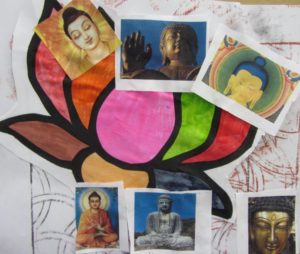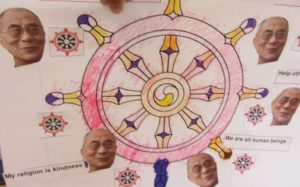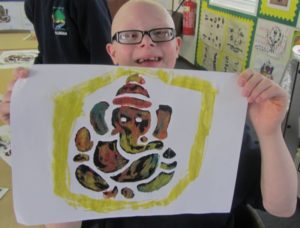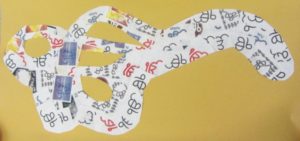5 Keys Into RE – Anne Krisman
01 February, 2013
A new inclusive way of planning for teachers of RE in special schools
Anne Krisman, Little Heath School, London Borough of Redbridge, 2013
This approach was joint first prize winner of the NATRE-Hockerill Award for Innovation in RE Teaching, 2011 http://www.hockerillfoundation.org.uk/Prize2.aspx
During a lesson on ’99 Names for Allah’ an autistic Hindu boy, when asked to give a new name for God, chose ‘The Key’. It became clear that he was choosing a name that linked with himself, and his own sense of being locked away from others. In the same way as the 5Ks of Sikhism define the identity of a Sikh, the 5Ks of RE are the bridge between a child with special needs and a theme in RE.
In this article, I will explore a new way of planning Religious Education for pupils with special needs in English and Welsh schools, presenting a simple structure that help bonds our pupils’ distinctive life experiences and understandings to the study of religion and human experience.
The distinctive life experiences of pupils with special needs
A visitor to my classroom, within a special school for pupils with autism and general learning difficulties, carried out a guided meditation within my RE lesson. The children had to imagine they were in a huge bubble, floating above the world. At the end of the reflection, they were asked to talk about what they had experienced. All the class shared stories about people they had died who they had loved, about fathers they did not see any more, or family living in Pakistan.
This is reflected by one sixth former with communication difficulties, Miriam, who comes into each RE lesson carrying the loss of her uncle, who died three years ago. Each theme is a springboard for her to talk about her uncle, who she explains, “Is in Heaven….still.”
When a group of pupils with moderate learning difficulties was told the parable of the Prodigal Son and asked to say what was lost in the story, many viewed it as a story about a broken family, as the mother is not mentioned in the text. When asked for the most important person in the story, one pupil stated, “It’s the mother, because she has died and has left her spirit in the heart of her sons.”

In order for pupils with special needs to access Religious Education, we have to understand what is distinctive about their life experiences and to mould what we teach to them. This means that we need to respond to their deep spiritual understanding of love and loss. Jerome Bruner’s work is relevant here; ‘we begin where the learner is, and we create interest in a subject by rendering it ‘worth knowing’ (1977, 31).
Issues in RE for children with special needs
Teachers working with children with special needs within English and Welsh special schools have few tailor-made resources and plans available in RE. There is no clear vision about what should be taught to children working at P (performance) levels, the assessment tool for use with those pupils who make progress both below and within the early levels of the National Curriculum (below level 1 – most seven year olds are expected to achieve level 2).
Schemes such as EQUALS adapt mainstream schemes of work, such as the QCA units, seeing these as their frame of reference. Most Agreed Syllabuses state that RE should be taught in special schools, “as far as is practicable” (1988, Section 71/7), but often just suggest that their units should be differentiated, with few guidelines on how to do this. Other authorities suggest that special schools often teach the content of the curriculum at a Key Stage below the actual age of the learners and that this should apply to the Agreed Syllabus.

As there is no conceptual framework available, it is common for teachers in special schools to attempt wide and varied sensory elements within RE. A Judaism theme could involve spinning a dreidel, touching or eating matzah, and wearing a kippah. These disparate experiences, while offering positive sensory opportunities, do not truly extend understanding of what it means to be a believer in a particular religion, because they are out of context.
Some teachers overlap Personal Social and Health Education ‘caring, loving and sharing’ activities into special needs RE, missing out on the distinctive elements of RE as a subject and the opportunities for spiritual development and the growth in skills that it offers.
A way forward for planning RE
I would like to suggest a new structure for planning Religious Education for children with special needs.
The ‘Five Keys Into RE’ planning grid and materials put the child as central (in the same way as ‘The Gift to the Child’ resources) and create authentic RE learning experiences that spring from the child’s needs. They develop themes in the document ‘Growing in RE’ (2008), recognising that children with special needs work more slowly and may need more time to discover the deeper meaning of RE. Therefore the focus is on the pure essence of what should be taught and experienced, not on differentiating mainstream concepts that may not have meaning for special school pupils. Emphasis is given to sensory and creative activities, but within an authentic RE context and with clear faith markers.

‘Learning about RE’, such as the symbols of beliefs, is not sidelined but given meaning by the 5 Keys structure, so teachers are clear what needs to be taught and how.
What is most important is that the 5 Keys approach gives a simple guiding structure that can be taken by teachers and used to develop their own schemes of work and resources. The aim is to provide a profound form of RE that goes beyond mere access. There should be a relationship between the child and the theme.
The 5 Keys grid takes five Key categories to help the teacher to focus their planning:
- Connection
- Knowledge
- Senses
- Symbols
- Values
Each key has a question for the teacher. Here are the keys with clarification in italics.
Connection – What links can we make with our pupils’ lives?
It is important to bond the pupil with the religious theme. Pupils with special needs have faced difficulty, struggle and loss in their lives and achieve often against tremendous odds. These themes are found in religion. To create a bridge, (a concept from the Warwick Religions Project), between the religious theme and the child means that the learning will be deeper. For example, work on the story of Diwali could begin with the idea that ‘sometimes we go away but it is good to be back home’. This Key here would link many pupils’ experience of respite care and their strong daily experience of getting on the school transport to go home with the story of Rama returning from exile.
Knowledge – What is at the burning core of the faith?
Special school pupils can take longer to process information. Rather than over-burdening the child with extraneous information, we need to look right into the heart of the religious theme and see exactly what knowledge what needs to be taught. It could be simply that Jesus loved everyone, especially if they were poor or unhappy, or that Sikhs have special teachers called gurus. This Key states that by cutting out peripheral information, but going straight to the core, we teach what is central and powerful.
Senses – What sensory elements are in the religion?
Special school pupils learn through their senses. This Key encourages teachers to look at a wide range of authentic sensory experiences that link with the theme. This could mean within a theme on Jewish prayer, listening to niggun melody, with repetitive sounds, or wrapping around with a large tallit.
Symbols – What are the symbols that are the most accessible?
Symbols are an important way of conveying the spirituality of the religion studied. They can be held, like a brass ik onkar, made the focus of art work, such as rubbing over a stencil of an om with crayon and adding glitter to make it beautiful, or experienced, such as using a hoop to symbolise a kara, and travelling around it again and again by walking or in a wheelchair. This would show the eternity of God. This Key therefore sees symbols as an encapsulation of the religion itself.
Values – What are the values in the religion that speak to us?
Pupils with special needs may have many difficulties but often like to help. They are aware of others helping them in their lives and the importance of saying thank you. This Key makes values central, so a unit on the life of the Buddha could focus on the importance of patience, using a Jataka story. This links with pupils needing to wait for help with their work, or waiting for the school transport to come at the end of the day.
The second column is Focus and here the Key question is answered by pointers to activities. Here is the Key question and Focus for ‘How and Why do Hindus Celebrate Diwali?’
| KEY | FOCUS |
|
Connection What links we can make with our pupils’ lives? |
We love to see light in the darkness.Sometimes we go away but it is good to come back home. We celebrate goodness in the world and want to get rid of evil. |
| KEY | FOCUS | ACTIVITIES |
|
Connection What links we can make with our pupils’ lives? |
We love to see light in the darkness.Sometimes we go away but it is good to come back home.
We celebrate goodness in the world and want to get rid of evil. |
Print out a picture found using ‘Light + shining’ search on Google. Use firework or ‘light’ colours, e.g., yellow and orange, to crayon onto paper and then cover with black. Scratch away to reveal light. Add picture on to this with PVA glue. Experience someone in the class going away and waving to everyone, and then the happiness when they return. Two types of Indian music, one contemplative, one lively. Look at pictures of the Diwali story and decide who is the baddie and who is good and kind? (Ravana). Look for clues in pictures. What things is it bad to do? What things are good? |
Finally, in the third column, teaching and learning experiences are given.
Transforming RE for children within special schools
This way of planning is presented as a way of transforming RE for children within special schools.
- It uses the strengths of children with special needs, for example, their sensory awareness and values, to develop 5 Keys into RE.
- It rejects a deficit model of RE for children with special needs, seeing them as having valuable life experience which enables them to access the themes of ‘real RE’.
- It uses the 5 Keys to develop appropriate creative RE work for the pupils, which is not superficial but gets to the heart of religion and human experience.
- It can be used smoothly across the key stages, with learning experiences varied in their level of difficulty according to pupils’ needs.
- It has been used to give pupils access to Jainism, Humanism and the Baha’i faith, which have been rarely taught within special schools.
- Each key can be used as an assessment opportunity when evaluating the units.
- There are more opportunities for innovation in how to present each section of the unit. Each key could have its own rituals and routines, a particular symbol always shown with a piece of music that connected with it, a values story always told while sitting on a particular rug or piece of material. This would give the unit an internal cohesion and the rituals that autistic pupils, for example, would respond to.
- The structure enables teachers to return to the units, but to set more challenging experiences, where appropriate. For example, in a ‘unity RE curriculum’, all pupils in the school could explore Sikh Gurus, or Easter, or Buddhist beliefs, but with differentiated activities. This would unite the school in common values and create links across age ranges and ability groups.
Some personal reflections on planning a theme using the 5 Keys Approach
The Little Heath School RE teachers initially reflected on the 5 Keys of ‘What Does it Mean to be a Sikh?’ It was clear that to understand a different culture, the pupils first needed to connect with the theme and to realise that they had special objects that were of value to them. In one Year 7 class, a group of pupils with autism and other complex needs, each had their own particular comforts and rituals, whether it was carrying around a dog-eared catalogue, the colour pink, Bollywood music, a special toy to chew, or sitting on a certain chair in the room.
By discussing and identifying these ‘comforts’, the RE teachers realised that they were beginning to understand the pupils more fully as individuals. Some of the pupils’ interests were then photographed, e.g., the very old catalogue that one boy carried around, and the class were shown the photos, with many reacting to the images and showing they linked them to their friends. This made the staff realise how well some pupils noticed each other.
It was only after this that pupils moved on to exploring objects special to Sikhs, such as the kara, carefully passing them around the group. The class also moved around in a circle to Sikh kirtan devotional music, to show the symbol of the kara. While listening to a recitation of Waheguru, the Sikh name for God, the children decorated an Ik Onkar symbol. They were completely hushed. When one pupil was given small Ik Onkar symbols to decorate his large Ik Onkar ‘One God’ symbol, despite his needs, he carefully made sure they were the right way up. Staff were surprised that the pupils concentrated for half an hour on their art work.
Exploring and Responding to Sikhism – What did Guru Gobind Singh teach Sikhs?’
Here, the work was carried out with 14 year old children with general learning difficulties. The aim was to connect the pupils to the life of Guru Gobind Singh by linking them with the 5Ks of Sikhism. Pupils chose their five most important elements in their lives before watching a video about the Sikh symbols. This included family and friends, but also interests and obsessions such as James Bond, wrestling and hats. Children were happy to share their identity and as always, the staff learnt more about them from their simple lists.
After writing the lists, the pupils watched online clips from the BBC about the 5Ks. One boy, after watching the films, said, “Sikhs say their hair is God’s silk”. The teacher and support assistants in the room were surprised at this spiritual comment. We then realised that he had misheard a phrase in the film – that Sikhs believe long hair is God’s will. However, his own extraordinary interpretation showed that he understood the meaning of uncut hair on a symbolic level.

Pupils listened to Guru Gobind Singh’s words about equality, which were at the burning core of the religion, ‘Know Ye the Human Race as One’ and there was a discussion about what this meant. One Somali girl was able to movingly share her own beliefs of everyone being equal and was able to connect her life experience with the difficult lives of the children in a similar school in India.
A more able group heard the story of soldier Bhai Khanayya, who gave water to his enemies on the battlefield. This illustrated Sikh values “None is my enemy, none a stranger. All human beings are my friend.” (Guru Granth Sahib). The class was then asked to create a new guru, using a sheet that tested their own ability to express values and key knowledge.
One 14 year old pupil with moderate learning difficulties, Rowan, chose a male guru. He stated that the guru must care about God and that the guru must never swear.
Given the sentence starter, ‘When the guru meets someone from another religion…..’ Rowan added, “he helps them.”
Asked to give three special words for the guru, Rowan wrote, “God In Us”.
Here Rowan misinterpreted the task, with the teacher expecting three unlinked descriptive words – but through his difficulties in reading, he provided something more spiritual, distilled and pure in terms of Sikh philosophy.
He finally created his guru’s promise to the Sikhs, “I will always be there to help you.”
Rowan, therefore, despite his difficulties in learning, has managed to understand the ‘burning core’ of Sikhism and what Guru Gobind Singh taught. This was helped by the 5 Keys structure.
Summary

I have described here some insights into how the 5 Keys approach has inspired some powerful work and responses from a range of pupils with special needs. The clarity of the approach means that teachers clearly understand what needs to be taught and why. This focus enables pupils to understand the heart of RE – if we know what we are communicating, the message is strong.
It is no accident that the approach also inspires many spiritual moments and insights. This is because the technique – bonding the pupil with the theme – means that we put our pupils at the centre of what we teach in RE. An emphasis on human values and creativity brings out the inner world of our special pupils and helps them to deal with life’s difficulties with hope and resilience.
References
Bruner, J. S. (1977). The Process of Education, Harvard University Press.
Grimmitt, M., Grove, J., Hull, J., Spencer, L. (1991) A Gift to the Child: Religious Education in the Primary School, Simon & Schuster Education.
Krisman, A., (2008) Growing in RE, RE Today Services.
Krisman, A., (1997) Speak from the Heart (Farmington Fellowship dissertation).
Schools Standards and Framework Act (1998).
